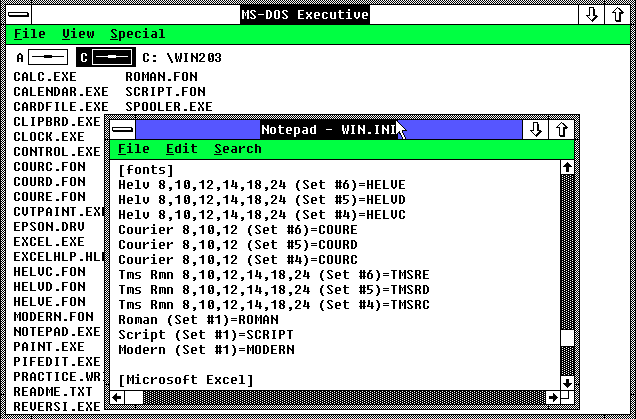Excel for Windows 2.x in Russian

Once, when I was a student, I used to walk with pairs and see - a bunch of five inch floppy disks scattered in the snow! My curiosity immediately sorted out what was on them? I got hold of a bag and began to collect them. At home, having dried them, spreading them all over the apartment on the floor, I began to examine their contents. The floppy registry was more than 300 pieces. Most utilities, compilers, computational programs, games and viruses. But there was also something unusual - an office suite (if you can call it 2 files of this program) Microsoft Excel 1988.
I had to run it on Windows 2.03 - very curious what the prototype of the now most powerful software product looks like!

')
But the Excel interface turned out to be in an unusual encoding - visually it looked like a CP866 without the installed cyrillic driver (it replaces the second part of the code 8-bit table with the Cyrillic). And then I realized: this is Russified Excel! On German Windows. As it was found out from other documents on diskette, the work on Russification was carried out, most likely, in the early 90s by local research institutes.
I began to look for the place where the display of characters is given. This is not a trivial task, because in Windows up to version 3 there was no system folder with fonts, there were scattered .FON files that were written in WIN.INI in the [FONTS] section.

However, these associations work only with additional fonts that can be used, for example, when formatting text in the editor. But the system font was “wired” in the WIN200.BIN file. It managed to be found thanks to characteristic sequences:

It was established experimentally that in my case the encoding started at offset 0x1500A, the character size was 8x15, and the characters were encoded starting from the 32nd (space). I wrote a simple little program so that you can quickly fix this font. Of course, it would be more correct to transfer there something from the Russified standard fonts. But now I am ashamed to even show the program itself :) Anyway, overnight the characters were redrawn and now the program looked like this:

Now, having rejoiced in such a wonderful transformation, let's see what he can do!
For example, auto-fill by the formula:

You can use numerous built-in functions. True, as a trace of the German version, many of them look unusual. "Sum", for example, here "SUMME ()":

From decorative lotions it is possible to stylize the contents of cells. For example, "shading";)

Or even play with fonts:

For any cell, you can set a footnote. Since there is no status line embedded in the interface editor, it can be seen by opening a special window where, when activated by the cell cursor, the contents of the footnote will be displayed:


If desired, the table can be printed through the system printer. The 9-needle matrix Epson FX-80 (registered in WIN.INI as DEVICE, EPSON.DRV driver) was registered in my system.

It is possible to record a sequence of actions in a macro with the assignment of a hot key:

The menu also contains the mysterious function of connecting to the database, but it does not work in any way:

And I did not understand one more function. Maybe someone will tell?

findings
The reader may ask: why do I need it? I became interested in researching decrepit software when more and more 80286 boards and processors began to appear in my collection of hardware. Even one 8088 was caught - just like the first IBM PC. Now imagine that Windows 2 and Excel 2 could work on them without any problems. Is that perhaps worth adding memory. I had an idea to use outdated machines for everyday tasks. I think that with spreadsheets it was more or less possible. There are some obvious interface disadvantages: lack of hotkeys for actions such as autocomplete; there is no automatic transition to the next cell when you press Enter; There is no support for Russian-language input (most likely, it is solved by the keyboard driver, but I have not met it). However, it is possible to keep journals with some calculations. By the way, in the help file to Excel (it occupies a third of the “distribution”), functions are described which are not in this version - there is even a plotting of graphs. The distribution kit weighs less than a megabyte with the usual size of hard drives of that time of 20 MB.
For those who are interested
Search the Internet for a set of diskettes called "1985 - MSDOS EXECUTIVE - Premiere Edition". These are 4 disks with a program for compilation, utilities and drivers.
There is also a set of diskettes for developers under C in nature. Now I can’t find it anymore, but probably there is something else in the “Vintage computing” section on ebay.com (for example, the full set of Windows 1.0 ).
I posted a patched WIN200.BIN and Excel 2.01 file on my site (I hope there will be no prosecution for distributing abandonware).
Source: https://habr.com/ru/post/166625/
All Articles